Qila mubarak 
In 1763
Baba Ala Singh laid the foundation of the Patiala fort known as
Qila Mubarak,around which the present city of Patiala developed.
The colorful and exuberant state of Punjab, the hot seat of India's cultural extravaganzas is opulent in grand palaces and majestic forts. Of the innumerable palaces and forts, the state boasts of, the Qila Mubarak Patiala, undoubtedly holds a special place.
The erstwhile residence of the famed Patiala dynasty, the Qila Mubarak Patiala is a rampart fort cum palace, surrounded by crenellated walls, battlements and turrets. The fortification however does not in any way diminish the beauty or the imperial grandeur of the palace.
The palace was built under the benevolent auspices of Maharaja Ala Singh in 1764. During its days of inception, Qila Mubark was merely a kuch-garhi of a mud fort that was later renovated into a rambling two-storied mansion with an imposing entrance with intricate arches. A large part of the fort however has been converted into a heritage museum.
The residential part of the palace that was inhabited by the royal members of the Patiala dynasty was known as the Qila Androon or the Inner Fort. Elegant living chambers for the royal prisoners aptly named the Jail Walla Palace accompany them. Besides the Moti Palace and Sheesh Palace, the Rajmata Palace, the Palace of Colors and the Palace of the Moon are the other eminent apartments the lavishly furnished and elegantly decorated palatial apartments.
Qila androom T
The entrance is through an imposing gate. The architectural style of this palace is a synthesis of late Mughal and Rajasthani. The complex has 10 courtyards along the north - south axis and each courtyard is unique in size and character, some being broad, others very small and still others mere slits in the fabric of building.Though the Androon is a single interconnected building.
Darbar hall U
Used for large audiences and important public occasions, the Darbar has been converted into a museum displaying dazzling chandeliers and armor, including the sword and dagger of Guru Gobind Singh and Nadir Shah's sword. The hall was built on a high plinth over a network of tunnels which were service conduits. The facade gives the impression of a double-storey building, with 'upper storey' windows and a balcony at the first floor level, but the delicately worked wood-and-glass doors open into a huge 15m-high chamber.
Sheesh mahal Introduction
IntroductionThe Sheesh Mahal or the `Palace of Mirrors` in Patiala (Punjab) was built by Maharaja Narinder Singh in 1845 behind the main Moti Bagh Palace. The Palace was built in a forest with terraces, gardens, fountains and an artificial lake. The lake has two watchtowers in the north and the south, and is connected to the Banasar Ghar, a storehouse for stuffed animals. The Sheesh Mahal, which was a residential palace, has a suspension bridge that is a copy of the Lakshman Jhoola at Rishikesh. A telling tribute to the days of the colorful Maharajas of Patiala, the Sheesh Mahal is part of the Qila Mubarak. Similar well-known rooms called "Sheesh Mahal" are also found in the palace of the Agra Fort, the Amber Fort of Jaipur, and the Harimandir Sahib.
HistoryThe then Maharaja of Patiala, Narendra Singh, built the Sheesh Mahal in 1847, and his much-admired aesthetic sense governed the design and decoration of this stunning palace to a substantial extent. The Sheesh Mahal`s greatest treasures are its excellent museum, a fine collection of antiques, which gives a fabulous insight into the life, and times of Maharajas of Patiala. The huge range of artifacts on display run the area from costumes and jewellery to portraits, Chinese mirrors, statues, engravings, utensils, weaponry and more. Besides artifacts pertaining to Patiala itself, there are objects from rest of India as well. Foremost among the galleries of the museum is the Medal Gallery, an awesome collection of more than 3,000 medals and coins from across the world, dating from the 12th to the 20th centuries.
Site & Architecture
Maharaja Narinder Singh was known to be a great sponsor of art and literature. He engaged great painters from Kangra and Rajasthan to paint the walls of the Sheesh Mahal with a variety of images pertaining to literature, mythology and legends. Their works portray the vision in the poetry of Keshav, Surdas and Bihari. The paintings also portray Raga-Ragni, Nayak-Nayika and Bara-masa in Rajasthani style. The walls and ceilings of the Sheesh Mahal are rich in floral designs and its interior is a kaleidoscope of images and multi-colored lights. Amongst the Sheesh Mahal`s most highly recommended displays are a series of Kangra-style miniatures depicting the Geet Govind, an epic poem by Jaidev. The Sheesh Mahal illustrates its name from the elegantly designed glass and mirror work, which covers an entire section of the palace.
The Sheesh Mahal also consists of a museum, which displays fine objects of Tibetan art, particularly the sculpture of different kinds of metals. `Bhupindar Singh`, Maharaja of Patiala in the 1920s, put the Sheesh Mahal Medal Collection together. His son, Maharaja Yadavindra Singh subsequently donated the medal collection to the people of the Punjab on India gaining independence in 1947 and the collection now lies in the Sheesh Mahal Museum. Although theoretically open to the public, gaining entrance to the museum can be difficult.
Various other items like the Ivory carvings of Punjab, royal wooden carved furniture, and a large number of Burmese and Kashmiri carved objects have also been exhibited. One can see huge portraits of the rulers of Patiala decorating the walls of museum hall. The museum`s collection also includes some rare manuscripts. Besides Janamsakhi and Jain manuscripts, the most valuable possession is the Gulistan-Bostan by Sheikh Sadi of Shiraz, which was acquired by the Mughal Emperor Shah Jahan for his personal library.
Included in the collection are also the five Victoria Cross medal groups, four of which were known, but the fifth VC group was never identified, until now.
The Victoria Crosses known to be in the Sheesh Mahal Collection are: 1. Captain George Day - Royal Navy (Crimean War).
2. Private John Dunlay - 93rd Regiment (Indian Mutiny).
3. Quartermaster William Odgers - Royal Navy (New Zealand).
4. Captain of the Forecastle John Taylor - Royal Navy (Crimean War).
5. Private Thomas Beach - 55th Regiment (Crimean War).

The Medal Gallery set up in the Sheesh Mahal has on display the largest number of medals and decorations in the world, numbering 3,200. Maharaja Bhupinder Singh from collected these all over the world. His illustrious son Maharaja Yadvindra Singh gifted this priceless collection to the Punjab Government Museum. The collection contains medals from England, Austria, Russia, Belgium, Denmark, Finland, Thailand, China, Japan and a host of other countries of Asia and Africa. Besides medals, there is a rare collection of coins. This numismatic collection presents a vast range from the punch-marked coins to those issued by the princely states in the 19th century. These coins characterize the Country`s history of trade, commerce, science and metallurgy.
A further discovery in the Sheesh Mahal Collection was that of a "New Zealand Cross" awarded to Assistant-Surgeon Samuel Walker for service during the Maori Wars. Only 23 crosses were awarded. An Order of Council, Wellington, New Zealand in 1869 to reward local volunteer forces to which the Victoria Cross was ineligible, instigated the "New Zealand Cross". The location of Walker`s New Zealand Cross was, until now, unknown by the Army Museum Waiouru, New Zealand.
Lakshman jhoola
Across the small Lake in front of Sheesh Mahal is a magnificent suspension bridge which being a replica of the famous Lakshman Jhoola at Rishikesh, is also named as Lachman Jhoola. It links the Sheesh Mahal with the Banasar Ghar on the other side of the lake. The Banasar Ghar now houses the North Zone Cultural Center and a hall for setting up exhibitions.
Baradari garden

There are some places in Patiala where people love to stroll around and spend some time in leisure. Baradari Garden is one amongst them.Baradari Garden is situated in the north of the old Patiala city and comes just outside the Sheranwala Gate. People of Patiala, working professionals, school children, visitors spend their time in this garden.
Gurudwara dhukhniwaran sahib

Gurdwara Dukh Nivaran Sahib: This shrine is situated in what used to be the village of Lehal, now part of Patiala city. According to local tradition, supported by an old handwritten document preserved in the Gurdwara, one Bhag Ram, a jhivar of Lehal, waited upon Guru Tegh Bahadur during his sojourn at Saifabad (now Bahadurgarh), and made the request that he might be pleased to visit and bless his village so that its inhabitants could be rid of a serious and mysterious sickness which had been their bane for a long time.
The Guru visited Lehal on Magh sudi 5, 1728 Bikram/24 January 1672 and stayed under a banyan tree by the side of a pond. The sickness in the village subsided. The site where Guru Tegh Bahadur had sat came to be known as Dukh Nivaran, literally meaning eradicator of suffering. Devotees have faith in the healing qualities of water in the sarovar attached to the shrine.
Raja Amar Singh of Patiala (1748-82) had a garden laid out on the site as a memorial which he entrusted to Nihang Sikhs. Records of a court case in 1870 mention a Guru's garden and a Nihangs' well being in existence here. In 1920, during a survey for the proposed construction of Sirhind-Patiala-Jakhal railway line, it appeared that the banyan tree under which had sat Guru Tegh Bahadur would have to be removed. But men charged with felling it refused to touch it.
Ultimately, Maharaja Bhupinder Singh ordered cancellation of the entire project. No gurudwara building had, however, been raised. It was only in 1930 that a committee was formed to collect funds and commence construction. The Gurdwara when completed passed under the administrative control of the Patiala state government. It was later transferred to the Dharam Arth Board of the Patiala and East Punjab States Union and eventually to the Shiromani Gurdwara Parbandhak Committee.
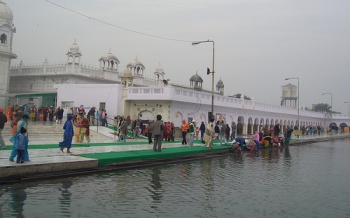
The sarovar adjacent to Gurdwara Dukh Nivaran, Patiala The building complex sprawls over several acres. The two storey gateway has a collapsible iron gate and black and white marble floor. On the left of the pathway leading to the principal building is a small marble shrine marking the site where Guru Tegh Bahadur had sat under the banyan tree. The central two storey building, with a domed pavilion on top, is on a raised base having an octagonal domed chamber at each corner. The pinnacled lotus dome on top has a round sun-window on each side with a curved coping, projected horizontally at the ends. There are decorative domed pavilions at the corners and lotus blossoms in leaf in the middle on top of the walls.
The interior is paved with marble slabs in white and grey against black and white of the outer platform. The walls and pillars are also panelled with white marble slabs. The ceiling is decorated with stucco work in floral design. The Guru Granth Sahib is seated under a square canopy at the far end. The 75metre square sarovar, since considerably extended, is on the right and Guru ka Langar on the left as one enters. The Gurdwara is administered by the Shiromani Gurdwara Parbandhak Committee. A big gathering is held on the fifth day of the light half of each lunar month. The festival of the year is Basant Panchmi which marks the day of Guru Tegh Bahadur's visit.
Gurudwara moti bagh sahib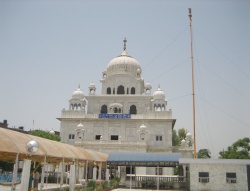 Gurdwara Moti Bagh Sahib
Gurdwara Moti Bagh Sahib (cordinates
(28.585833°N 77.171396°E)) is situated on the Ring Road (Mahatma Gandhi Marg) in
Delhi city between Dhaula Kuan and RK Puram (Shanti Path) south of the intersection with National Highway 8. Once
Guru Gobind Singh ji camped at this site with his army. Earlier it was known as Mochi Bagh and later the name was changed to Moti Bagh. An old story relates that the Guru, an accomplished archer, shot two arrows from a colony of cobblers in Moti Bagh which hit the 'Divan' (throne or bed) of
Prince Muazzam (later Bahadur Shah).
The Guru's first arrow announced his arrival in Delhi and the second arrow carried a chit saying, "It is not magic but skill of archery". Bahadur Shah was said to be sitting in the Red fort at the time. Seeing the arrow strike, Bahadur Shah took this as a miracle. The story continues that a second arrow landed in the Divan's left foot with a note (chit) pointing out that the Emperor was wrong in labelling the sudden appearance of an arrow in his cot as a miracle, as the note stated that this was not a miracle but a display of the Guru's skill in archery. The Emperor was said to be so impressed with this that he immediately acknowledged Guru Sahib's supremacy.
Kali devi mata temple
The
Kali Devi Temple, devoted to the deity Durga, is one of the holiest places of reverence for the Hindus in Punjab. This temple is situated on the renowned Mall Road in Patiala, Punjab. The eye catching architectural pattern of this temple makes this place the main attraction for the people who visit the town of Patiala. The royal family of Patiala constructed this architectural monument, which is now a significant shrine of the city’s history. The
Kali Devi Temple helps the devotees to experience the divine presence of the Goddess Durga.
The temple is situated in the remote area of Patiala, away from the city’s chaos. The serene surroundings of the
Kali Devi Temple endow with eternal peace the souls and minds of the people who visit this place. One can witness the traditional rites and rituals that are performed at this temple, which are slowly fading away with the modern times. This temple strictly follows the traditional rituals and customs of the past, and encourages the disciples and devotees to follow the same path.
The sacred Kali Devi Temple houses the illustrations of the bygone era. The walls of this temple are adorned with splendid sceneries and skillful mural paintings, ornamenting this holy place. This temple is bestowed with the title of 'National Monument'. The aesthetic appeal and the serenity of the
Kali Devi Temple allure tourists who visit this revered temple in the quest of solace.
Qila bahadurgarh

At a distance of one and half kilometer from the main gate of Punjabi University, It is named so to commemorate the holy memory of Guru Tegh Bahadur who paid visit to this place at the invitation of another holy person Saif Khan. The four wails of the fort enclose the village Saifabad located on the left-side of the Rajpura-Patiala Road. Saif Khan, a relative of the Mughal Emperor Aurangzeb, after holding several important offices, became a hermit and settled down here. After his death he was buried here.
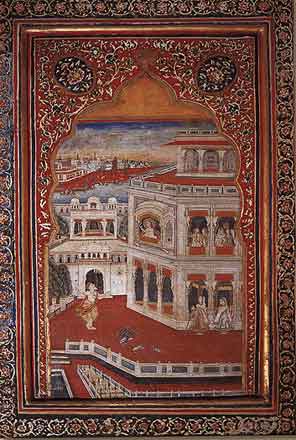

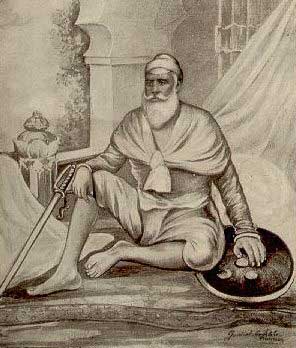
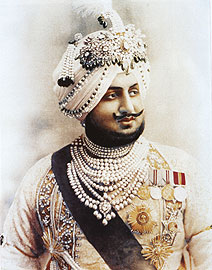









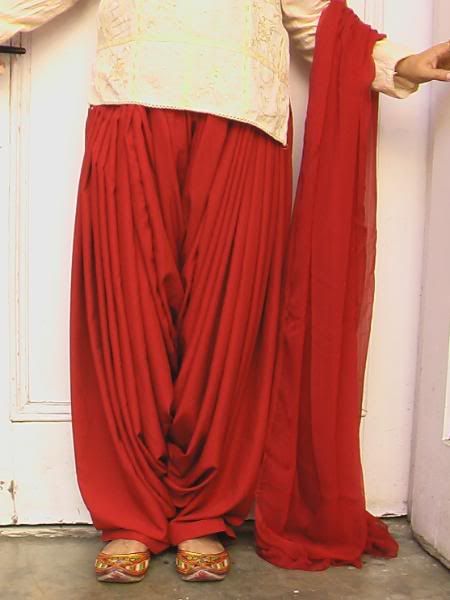


























 The Medal Gallery set up in the Sheesh Mahal has on display the largest number of medals and decorations in the world, numbering 3,200. Maharaja Bhupinder Singh from collected these all over the world. His illustrious son Maharaja Yadvindra Singh gifted this priceless collection to the Punjab Government Museum. The collection contains medals from England, Austria, Russia, Belgium, Denmark, Finland, Thailand, China, Japan and a host of other countries of Asia and Africa. Besides medals, there is a rare collection of coins. This numismatic collection presents a vast range from the punch-marked coins to those issued by the princely states in the 19th century. These coins characterize the Country`s history of trade, commerce, science and metallurgy.
The Medal Gallery set up in the Sheesh Mahal has on display the largest number of medals and decorations in the world, numbering 3,200. Maharaja Bhupinder Singh from collected these all over the world. His illustrious son Maharaja Yadvindra Singh gifted this priceless collection to the Punjab Government Museum. The collection contains medals from England, Austria, Russia, Belgium, Denmark, Finland, Thailand, China, Japan and a host of other countries of Asia and Africa. Besides medals, there is a rare collection of coins. This numismatic collection presents a vast range from the punch-marked coins to those issued by the princely states in the 19th century. These coins characterize the Country`s history of trade, commerce, science and metallurgy.





